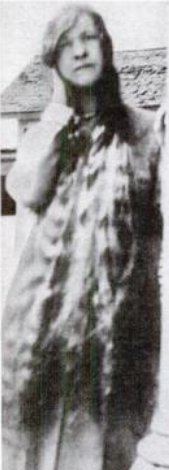Occupation Laborer, labor leader Name Mary Brown | Died April 1991 | |
 | ||
Parent(s) Frank Wolf Babnik and Mary Babnik | ||
Mary Babnik Brown (November 22, 1907 – April 14, 1991) was an American who became known for having donated her hair to the United States military during World War II. Thirty-four inches long (86 cm), her blonde hair had never been chemically treated or heated with curling irons, and therefore proved resilient enough to use as crosshairs in Norden bombsights for bomber aircraft, which have to withstand a wide range of temperatures and humidity.
Contents
Brown declined compensation for her donation, believing what she had done was her patriotic duty. She was told at the time only that the hair was needed for meteorological instruments, and had no idea how it had been used until 1987. President Ronald Reagan wrote to her that year on her 80th birthday to thank her, and in 1991 she received a special achievement award from the Colorado Aviation Historical Society during a ceremony at the Air Force Academy in Colorado Springs.
Early life
Brown (née Babnik, often misspelled Babnick) was born in Pueblo, Colorado, to Frank and Mary Babnik, immigrants from Slovenia. Her father worked at the railroad and her mother was a domestic helper. Her parents named her Mitzi, a Slovenian name, but she Americanized it to Mary. The oldest of the children, she had three younger siblings; her sister, Josephine, arrived in 1908, followed by two brothers, Frank in 1910 and Joseph in 1912. Brown spent her early childhood in the Bessemer and Grove neighborhoods of Pueblo. Her father abandoned the family around 1920, leaving her mother to raise the children.
Brown left elementary school when she was 12 years old to help support the family. She first obtained part-time domestic work for $5 a week. By lying about her age when she was 13, she was able to find a permanent job at the National Broom Factory, which paid 75 cents a day when she started; she ended up working there for 42 years. Her siblings contributed to the family financially by picking up chunks of coal on railroad tracks that had fallen from steam-engine trains.
Brown became a well-known dancer in Pueblo. She began dancing as a hobby in her early teens, winning her first dancing contest at the age of nineteen. She danced so often at the Arcadia Ballroom (now razed) on Fifth Street in downtown Pueblo that her nickname was "Arcadia Mary". During World War II she taught GIs how to dance. She had a saying: "My first love is my family, but dancing is my second."
Hair donation
In 1944 Brown was the first woman to have her hair used for military aircraft bombsights. She saw an advertisement in a Pueblo newspaper in 1943 that said the government was looking for hair from women for the war effort, although no details were given as to how it would be used. The ad said only that they wanted blonde hair that was at least 22 inches long (56 cm), and which had not been treated with chemicals or hot irons. The women's hair collection for use as bombsight crosshairs was a clandestine operation even though they found the hair through a newspaper advertisement.
The Army Air Forces had tried several different materials for the crosshairs of the Norden bombsight, a carefully guarded, state-of-the-art instrument that aimed bombs at their target. The bombsight was used on the B-24 Liberator, B-29 Super Fortress and B-17 Flying Fortress military aircraft. It was so secret that it was surrounded by booby-trapped charges that the crew were ordered to detonate if it appeared that the bombsight might be seized by the enemy.
According to Doug Adams, black widow spider webbing had been tried for the crosshairs, but it could not withstand the variations in temperature to which the bombsight would be exposed. In contrast, fine blonde human hair that had not been treated with chemicals or heat was found to be reliable in a wide range of climatic conditions, including at 20,000 feet and below freezing.
Brown's hair was 34 inches (86 cm) long and had never been cut, chemically treated or heated with irons. It was her most prized possession. She washed it with "pure soap" twice weekly and combed it twice a day; it stretched down to her knees when she combed it out. She normally wore it wrapped around her head in a braid, and as a result was known as the "lady with the crown".
The government purchasing agent at the Washington Institute of Technology told her that her hair would be used for meteorological instruments. She sent off samples, and they concluded that it would be appropriate for the crosshairs. Brown agreed in 1944 to have it cut. The government offered to pay her for it in war savings stamps, but she refused, seeing it as her duty to help in the war effort. She ended up feeling traumatized by the loss of it, and cried for two months afterwards.
As well as being used for bombsight crosshairs, Brown's hair was also used in scientific equipment to make precise measurements of humidity, paramount in the production of military aircraft and other war equipment. Brown's hair was the first woman's hair used as crosshairs in military aircraft bombsights.
Later life
Brown married Carl Brown sometime after 1944, and became Mary "Mitzi" Babnik Brown. In 1947 she became vice president of the State Federation of Labor, the first woman to hold that position. She also became an active member of the Pueblo Democratic party, and was the vice president and president of the Slovenian Lodge SNPJ (Slovenian National Benefit Society). She spent her last years of her life in the 300 block of Spring Street in Pueblo.
